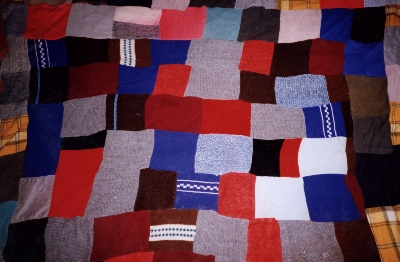Quilt No.631PWH - The Pioneer Women's Hut

1860 x 1410mm
This is typical of the many quilts made by Elsie Shephard of Rosewood NSW over a 20 year period from 1957 for use in her home. Elsie donated it to The Pioneer Women's Hut. It is displayed occasionally in the museum.
"Patch Work Rugs
When my husband was seriously hurt in a road accident in 1956 he was in hospital for a year then another two years recovering until he was fit enough to get a permanent job. There were no Government handouts to needy families then so you had to do your best to balance the budget and make ends meet.
Having a young family people were very kind to me, giving me clothes for my children their children had grown out of that were in good order, some were slightly worn and needed patching.
When my husband had a permanent job people still gave me clothing because I had six children, even though I could afford to buy clothes for them. Because of their kindness I could never say 'no'. I would thank them saying 'nothing will be wasted, I'll make use of what you have given me'.
Being so cold at Rosewood I decided to make patch work rugs for all my children's beds out of garments I knew would never be worn, keeping my word 'I'll make use of what you have given me'.
There was no design or pattern in anything I made, I just kept cutting things up into squares, then stitching the squares together into rows, then sewing the rows together. Whatever colour was in the bobbin I sewed with. I never lined the rugs as I had always sewn enough squares together to just fold the sewn rows over and have the rug doubled. I made some rugs for my husband to take camping.
My eldest daughter slept in the coldest room ub the house. One night I finished her rug, put a lining in it and put it on her bed when she was asleep. It was that heavy that during the night she woke up thinking an animal was on top of her bed! I took the lining out."
[Elsie Shephard, Rosewood NSW 1.4.2000]
Related Quilts:
1956 x 1702mm
No quilting.
2312 x 1905mm
2515 x 1829mm
2250 x 2180mm
1600 x 1500mm
2261mm x 1664mm






